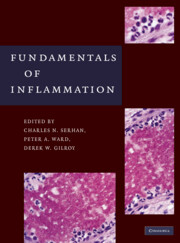Book contents
- Frontmatter
- Contents
- Contributors
- Preface
- PART I THE INFLAMMATORY RESPONSE – AN OVERVIEW
- PART II INDIVIDUAL CELL TYPES
- 4A Neutrophils I
- 4B Neutrophils II
- 5 Mast Cells as Sentinels of Inflammation
- 6 Basophils
- 7 Eosinophils
- 8 Macrophages
- 9 Lymphocytes
- 10 Fibroblasts and Stromal Cells
- 11 Neutrophil–Endothelial Cell Interactions
- PART III CHEMICAL MEDIATORS
- PART IV IMMUNOPHARMACOLOGY
- PART V INFLAMMATORY DISEASES/HISTOLOGY
- PART VI ANIMAL MODELS OF INFLAMMATION
- Index
- References
8 - Macrophages
from PART II - INDIVIDUAL CELL TYPES
Published online by Cambridge University Press: 05 April 2014
- Frontmatter
- Contents
- Contributors
- Preface
- PART I THE INFLAMMATORY RESPONSE – AN OVERVIEW
- PART II INDIVIDUAL CELL TYPES
- 4A Neutrophils I
- 4B Neutrophils II
- 5 Mast Cells as Sentinels of Inflammation
- 6 Basophils
- 7 Eosinophils
- 8 Macrophages
- 9 Lymphocytes
- 10 Fibroblasts and Stromal Cells
- 11 Neutrophil–Endothelial Cell Interactions
- PART III CHEMICAL MEDIATORS
- PART IV IMMUNOPHARMACOLOGY
- PART V INFLAMMATORY DISEASES/HISTOLOGY
- PART VI ANIMAL MODELS OF INFLAMMATION
- Index
- References
Summary
INTRODUCTION
Macrophages are a major leukocyte involved in orchestrating inflammatory responses. Their name is derived from the Greek term “big eaters” (makros, large; and phagein, eat). This gives some insight into the primary function of this cell in clearance of invading pathogens, cell debris, and apoptotic cells by a process of engulfment and digestion called “phagocytosis.” However, the role of the macrophage goes beyond that of what its name suggests. They are endowed with the ability to rapidly react to and secrete a plethora of biological agents and mediators that can influence the initiation, progression, and resolution of an inflammatory response and coordinate processes to establish acquired immunity against specific pathogens. This chapter is an overview of the basics of macrophage biology and function, with particular insights into the involvement of macrophages in disease pathogenesis as well as pharmacological modulation of macrophage responses as targets for treatment of disease.
IDENTIFICATION
Historical Discovery
Elie Metchnikoff first used the term “macrophage” to describe large mononuclear phagocytic cells he observed in tissues over 100 years ago. Macrophages are now recognized as the major phagocytic cell type with diverse characteristics and localities around the body where they are important for both innate and acquired immune responses as well as maintenance of tissue homeostasis and regulation of various processes subsidiary to the immune defense such as hematopoiesis.
- Type
- Chapter
- Information
- Fundamentals of Inflammation , pp. 96 - 106Publisher: Cambridge University PressPrint publication year: 2010



